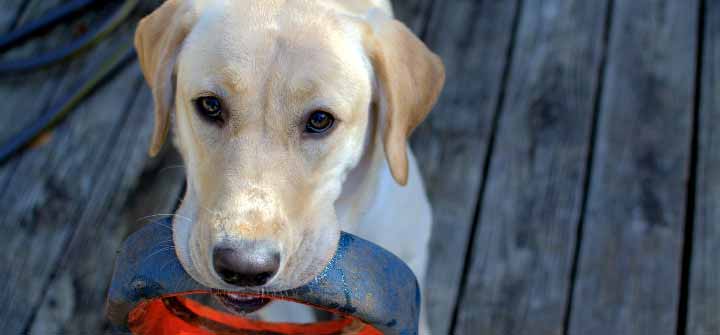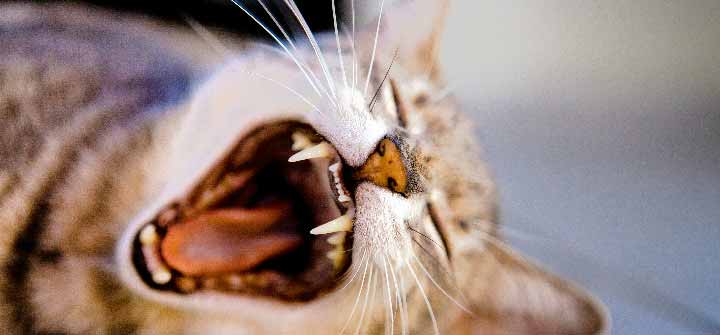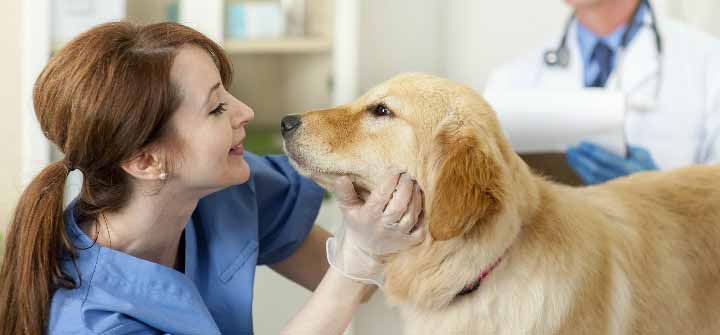We are taught from a young age the need for good dental hygiene and regular dental checkups. But as pet guardians, we may not be aware of the significance of pet dental health – and how it relates to our pet’s overall well being. Unfortunately it is often only made clear to us only when the damage is significant and, at times, irreversible.
So how can you take charge of your pet’s most used assets – their teeth – before the damage is done?
Chew on this
On average dogs have 42 teeth and cats typically have around 30. To put this in perspective humans have 32. Studies have shown that a pet is more likely to lose teeth from lack of care, and will experience more wear and tear on their teeth throughout their lifetimes than people.
Just think about all the things your dog loves to chew.

Elyse Cannon is a Certified Veterinary Technician, Claims Specialist, and Veterinary Medical Manager at Petplan. She offers guidance on how to prevent chewing-related oral health issues in dogs.
“If you give your dog items to chew on, the general rule is that you should be able to make an indention in the item by pressing it,” Cannon says. “Things like bones, antlers and hooves can cause the teeth to fracture, which can be very painful.”
Cannon recommends giving your dog treats such as C.E.T Chews – known as enzymatic oral hygiene chews. They contain a natural antiseptic, and are textured to help loosen plaque as your dog chews. As an added benefit, they give your pet something safe and tasty to nibble on when they get bored.
The basics of good pet dental health
The good news is that you can make your pet a dental superstar through daily hygiene, a proper diet, and annual dental cleanings.
One of the most important ways you can care for your pet’s mouth is by brushing her teeth every day. You can use specially designed pet toothbrushes or, if your dog or cat prefers, finger brushes. These are softer and more flexible, consisting of a small rubber tip with tiny projections. As the name suggests, they fit over your finger.
Consult your veterinarian about adding a dental rinse to your pet’s drinking water. Most additives are tasteless. They work by creating a coating that makes it more difficult for plaque to adhere to the teeth.
And consider what you are feeding your pet.
Many cats will develop tooth resorption during their lifetimes. This condition erodes the dentin, one of four major components of teeth. Some veterinarians recommend a combination of wet and dry food to reduce the chances of erosion. The hard food will allow a scraping action to remove plaque, while the wet food gives cats hydration essential to good kidney function.

For dogs, the general consensus is that an all dry food diet is fine. Larger-sized kibble seems to be better for plaque removal, but make sure the kibble is not too large for the size of your dog’s mouth or teeth.
The final preventative step towards optimal pet dental health is an annual dental exam and cleaning.
“Not all pets need annual dental cleanings,” Cannon says, “but that cleaning should be done if it is necessary.”
Grading periodontal disease
If a veterinarian determines that your pet has signs of periodontal disease, the next step is grading its severity.
• Stage 0 or 1 is usually the point at which the doctor will recommend a routine dental cleaning. This means that your pet has some evidence of calculus and gingivitis, or inflammation of the gums. Teeth look healthy, and there are little to no signs of gum recession.
• Stage 2 indicates that there is some noticeable calculus – or tartar, which is hardened plaque – on the teeth. This can cause the affected teeth to loosen and is considered early periodontitis.
• Stage 3 indicates a more severe case of periodontal disease. There is an obvious loss of tooth support. Left untreated, serious periodontal disease can lead to damage to internal organs over time.
• Stage 4 is advanced periodontal disease, where more than half of the tooth’s support has been compromised. Pets at this stage will typically require tooth extraction in order to stop further progression of the disease.
Bad for the mouth is bad for the body
Poor dental health can have serious health consequences for your pet that reach far beyond his mouth. In fact, oral disease is one of the most frequently diagnosed health problem in dogs and cats beyond the age of three. The mouth is a perfect breeding ground for bacteria and oral issues can quickly become a major health issue.

Infections caused by the toxins created from oral bacteria can be transported through a pet’s bloodstream. This can lead to problems with multiple organs, including the liver, the kidneys and most commonly, the heart. Toxins can attack the valves of the heart, diminishing their capacity and increasing the likelihood of cardiac failure.
It is critical not to wait until your pet shows signs of oral discomfort. Many animals mask pain, according to Petplan’s Cannon, but reveal it through other behaviors.
“Not wanting to chew, dropping kibble when eating, halitosis, and shying away from petting around the head or mouth area,” Cannon says are all signs that your pet may have dental disease.
An ounce of prevention is worth a pound of cure
February is National Pet Dental Month, during which time many veterinarians offer discounts for dental procedures. If your pet needs non-urgent dental care – including a cleaning – this is a good time to schedule the procedure and save money. Cleanings can be costly: animals must be anesthetized, and radiographs, blood work, and other tests are typically done prior to the procedure.
Yet if your pet needs significant dental care – including extractions – do not let cost be a deciding factor. Pet health insurance companies can “sometimes cover partial costs of dentals for pets who have severe dental disease,” explains Petplan’s Cannon.
Preventative procedures will save you money in the long run, by avoiding more serious dental issues as well as other health problems. They will spare your pet unnecessary pain and suffering as well.
Companion pets are family, and their longevity is dependent upon their health. Help your pet live a long, happy and pain free life by practicing preventative dental care.












I have a 2 year old American Eskimo. I’m taking all her had bones away, and going to get dental stuff tomorrow and make a check up next week! Thx for an excellent article!
That’s great news, Peter! So glad you found the article helpful.
Caring for our pets teeth is so important! Thank you for this great blog!